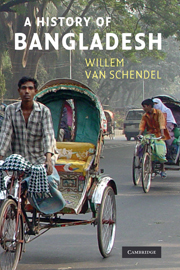Book contents
- Frontmatter
- Contents
- List of plates
- List of maps and figures
- Acknowledgements
- Timeline
- Introduction
- PART I THE LONG VIEW
- PART II COLONIAL ENCOUNTERS
- PART III BECOMING EAST PAKISTAN
- 11 The Pakistan experiment
- 12 Pakistan falls apart
- 13 East Pakistani livelihoods
- 14 The roots of aid dependence
- 15 A new elite and cultural renewal
- PART IV WAR AND THE BIRTH OF BANGLADESH
- PART V INDEPENDENT BANGLADESH
- Conclusion
- Bangladesh district maps
- Key political figures since 1947
- Glossary of Bengali terms
- Notes
- Bibliography
- Index
14 - The roots of aid dependence
Published online by Cambridge University Press: 05 February 2015
- Frontmatter
- Contents
- List of plates
- List of maps and figures
- Acknowledgements
- Timeline
- Introduction
- PART I THE LONG VIEW
- PART II COLONIAL ENCOUNTERS
- PART III BECOMING EAST PAKISTAN
- 11 The Pakistan experiment
- 12 Pakistan falls apart
- 13 East Pakistani livelihoods
- 14 The roots of aid dependence
- 15 A new elite and cultural renewal
- PART IV WAR AND THE BIRTH OF BANGLADESH
- PART V INDEPENDENT BANGLADESH
- Conclusion
- Bangladesh district maps
- Key political figures since 1947
- Glossary of Bengali terms
- Notes
- Bibliography
- Index
Summary
Pakistani policy-makers saw themselves as champions of modernisation. They were confident that they knew how to jog the sluggish economy into a high gear and thus bring about ‘development’. What they needed was money and a population that would follow their lead.
To be sure, this was nothing new. Agricultural stagnation in the Bengal delta had first become a policy concern in the early twentieth century. The colonial authorities noticed that a closing agrarian frontier and population growth led to stagnating agrarian output and declining rural incomes. This prompted the first attempts at rural development (or ‘rural rehabilitation’, as it was then called): experiments with village cooperative societies, debt relief, crop research, agricultural extension and the application of fertilisers. Although most initiatives came from the government, some non-governmental organisations (such as the Salvation Army) were also active. The roots of development policy, today such a central theme in Bangladesh, reach back more than a century.
From the birth of Pakistan, the central government saw itself as devoted to development. It assumed an interventionist role, but the funds it released were unimpressive. It also overrated its capacity to transform the economy: ‘with few exceptions, projects financed by the centre were among the finest textbook cases of abysmal planning, widespread corruption and gross mismanagement.’
After the coup of 1958 the military regime presented itself as the only force capable of modernising Pakistan.
- Type
- Chapter
- Information
- A History of Bangladesh , pp. 144 - 151Publisher: Cambridge University PressPrint publication year: 2009



